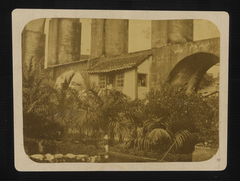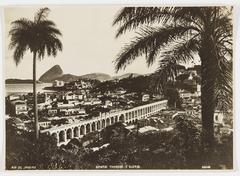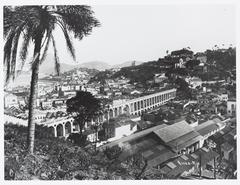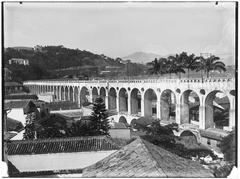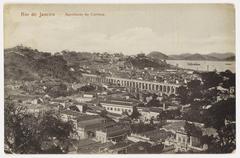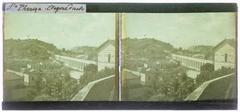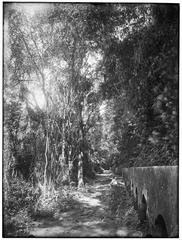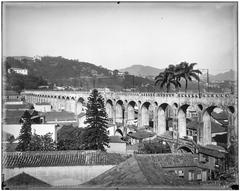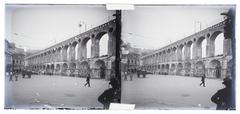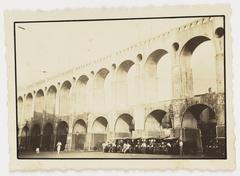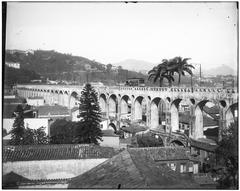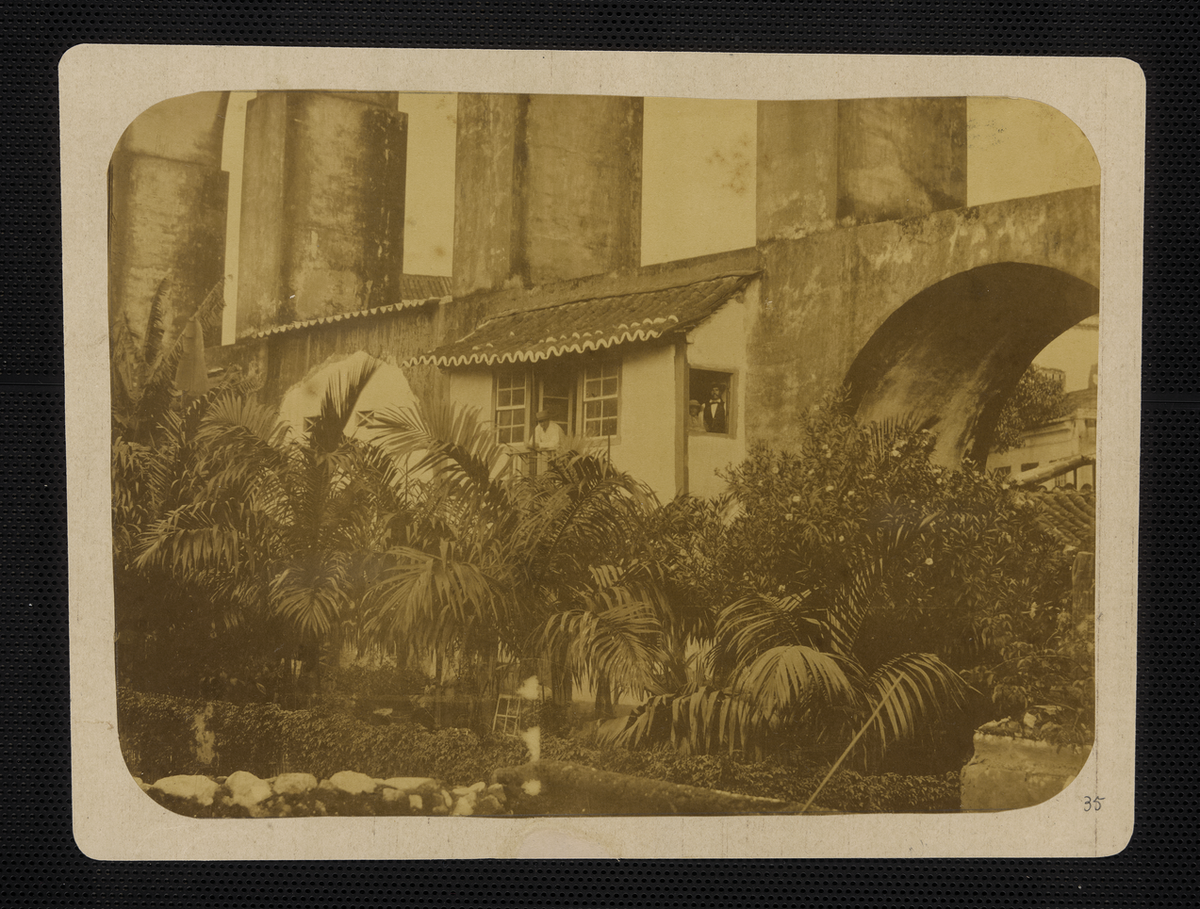
Carioca Aqueduct: Visiting Hours, Tickets, and Complete Guide to Rio de Janeiro’s Historic Landmark
Date: 14/06/2025
Introduction
The Carioca Aqueduct, or Arcos da Lapa, is one of Rio de Janeiro’s most enduring symbols, standing at the intersection of colonial history, architectural brilliance, and vibrant urban culture. Originally constructed in the 18th century to address a critical water shortage, this iconic structure now serves as both a striking monument and a vital part of the city’s transport network, supporting the historic Santa Teresa tramway. Nestled in the heart of the dynamic Lapa neighborhood, the aqueduct is a focal point for cultural gatherings, nightlife, and artistic expression.
This guide provides comprehensive information for visitors: from a detailed history and architectural overview to practical tips on visiting hours, tram tickets, accessibility, cultural events, and nearby attractions. Whether you are a history enthusiast or simply looking to experience the unique energy of Rio de Janeiro, the Carioca Aqueduct is an essential stop on your itinerary (riomemorias.com.br; worldtoptop.com; freewalkertours.com).
Table of Contents
- Origins and Construction
- Function and Urban Impact
- From Aqueduct to Tram Viaduct
- Architectural Features
- Visiting Information
- Nearby Attractions
- Cultural Events and Guided Tours
- Photographic Spots
- Social and Cultural Legacy
- Preservation and Heritage Status
- Aqueduct in Contemporary Rio
- Frequently Asked Questions (FAQ)
- Summary & Travel Tips
- References
Origins and Construction
The Carioca Aqueduct traces its origins to the early 18th century, when Rio de Janeiro struggled with water scarcity. The initial phase, completed in 1723, utilized iron pipes to channel water from the Carioca River, but the tropical climate led to rapid deterioration. Recognizing the need for a lasting solution, Governor Gomes Freire de Andrade commissioned a new structure in 1744 using stone, lime, and whale oil, a blend that produced a resilient colonial concrete. Completed in 1750, the aqueduct featured 42 majestic Romanesque arches in two tiers, stretching 270 meters and soaring up to 17.6 meters high. This feat of colonial engineering transformed urban life, providing a reliable water supply that supported population growth and improved public health (riomemorias.com.br; worldtoptop.com).
Function and Urban Impact
The aqueduct’s primary role was to deliver fresh water from Corcovado Mountain’s Carioca River to public fountains in the city center, notably the Carioca Fountain at the foot of the Convent of Santo Antônio. This innovation replaced the labor-intensive method of water carriers—many of them enslaved Africans and Indigenous people—thus facilitating urban expansion and improving sanitation (riomemorias.com.br). The structure also influenced the city’s development, laying the foundation for Lapa’s evolution into a vibrant cultural and nightlife district (en.wikipedia.org).
From Aqueduct to Tram Viaduct
By the late 19th century, advances in water distribution rendered the aqueduct obsolete for its original purpose. In 1896, the arches were repurposed as a viaduct for the Santa Teresa tramway—a unique yellow tram connecting downtown Rio to the artistic Santa Teresa neighborhood. This adaptation preserved the aqueduct’s legacy, making it the only functioning tram line in Rio today and offering panoramic views of the city (worldtoptop.com; freewalkertours.com).
Architectural Features
The aqueduct is renowned for its two-tiered arcade of 42 Romanesque arches, constructed with a mixture of stone, lime, and whale oil—a testament to colonial ingenuity (worldtoptop.com). The striking whitewashed arches contrast with the lively Lapa neighborhood and the hills of Santa Teresa, creating a dramatic urban landmark. The visible segment in Lapa is the most iconic and best-preserved, often depicted in art and photography as a symbol of Rio’s resilience and modernization (riomemorias.com.br).
Visiting Information
Visiting Hours
- Aqueduct Area: Open to the public 24/7, free of charge.
- Santa Teresa Tramway: Operates daily, typically from 7:00 AM to 7:00 PM, though hours may vary for maintenance or special events (Royal Caribbean). Check current schedules before visiting.
Tickets and Entry
- Aqueduct: Free public access.
- Santa Teresa Tram: Tickets are around R$20 for a round trip. Purchase tickets at the tram station or through authorized vendors. Discounts may apply for residents and seniors.
Accessibility
- The area around the aqueduct is mostly flat and wheelchair accessible. However, the historic tram may not be suitable for visitors with mobility impairments due to stairs and vintage design. Always check accessibility details in advance.
Travel Tips
- Best Times: Visit early morning or late afternoon for ideal lighting and fewer crowds.
- Safety: Lapa is generally safe, especially during the day and in well-populated areas at night. Exercise normal precautions: avoid displaying valuables and stick to main routes (The Unknown Enthusiast; Chris & Sara).
- Comfort: Wear comfortable shoes, bring sunscreen, and carry a filtered water bottle (Travel Cami).
Nearby Attractions
- Escadaria Selarón: The world-famous mosaic staircase linking Lapa and Santa Teresa.
- Santa Teresa: Bohemian neighborhood with art galleries, cafes, and sweeping city views.
- Rio de Janeiro Cathedral: Modern architectural marvel nearby.
- Convent of Santo Antônio: Historic site close to the original Carioca Fountain.
Cultural Events and Guided Tours
The Arcos da Lapa often serve as the stage for street parties, samba nights, Carnival parades, and cultural festivals, particularly on weekends. Guided walking tours are widely available, offering rich historical and cultural context for the aqueduct and the neighborhoods it connects (Touropia).
Photographic Spots
- Largo da Lapa Square: Iconic frontal view of the arches.
- Rua Riachuelo: Great for side perspectives.
- Santa Teresa Tram: Offers panoramic shots of both the structure and the city.
- Escadaria Selarón: Unique vantage point for creative compositions.
Social and Cultural Legacy
Built with the labor of enslaved Africans and Indigenous people, the aqueduct is a reminder of the city’s complex colonial history (Cambridge Urban History). Its presence transformed daily life, supporting urban growth and symbolizing both the hardships and advancements of Rio’s past. Today, the aqueduct’s arches stand as a testament to resilience, creativity, and the city’s ever-evolving social fabric (jogaprarolorio.com).
Preservation and Heritage Status
The Carioca Aqueduct was designated a national heritage site by IPHAN in 1938, guaranteeing its preservation for future generations (jogaprarolorio.com). Its protected status ensures ongoing conservation efforts and highlights its significance in Brazil’s architectural and cultural history.
Aqueduct in Contemporary Rio
Today, the aqueduct is a thriving hub for nightlife and culture. The area beneath the arches, Largo da Lapa, is alive with music, street art, and festivals—making it a favorite gathering place for locals and visitors. The Santa Teresa tram remains a beloved experience, providing a living link between Rio’s past and present (freewalkertours.com; Touropia).
Frequently Asked Questions (FAQ)
Q: Is there an entry fee to visit the Carioca Aqueduct?
A: No, the aqueduct is free to visit. Tickets are required only for the Santa Teresa tram.
Q: What are the visiting hours for the aqueduct and tram?
A: The aqueduct is always accessible; the tram usually runs from 7:00 AM to 7:00 PM.
Q: How do I get to the Carioca Aqueduct?
A: Take the metro to Cinelândia or Carioca stations, or use taxis and ride-shares. The tram can be boarded downtown.
Q: Is the area wheelchair accessible?
A: The plaza is mostly accessible; the tram is not fully adapted.
Q: Are guided tours available?
A: Yes, several operators offer walking tours covering the aqueduct, Lapa, and Santa Teresa.
Q: What’s the best time to visit?
A: Weekdays and early mornings are less crowded. Evenings are lively but busier.
Summary & Travel Tips
The Carioca Aqueduct is a must-see for anyone exploring Rio de Janeiro’s historical sites. Its monumental arches, rich colonial history, and central role in Rio’s cultural life make it an unforgettable destination. Enjoy free access at any time, ride the iconic tram, and immerse yourself in the vibrant spirit of Lapa. Plan ahead by checking tram schedules and considering a guided tour for deeper insights. Be sure to explore nearby attractions like the Selarón Steps and Santa Teresa for a full Rio experience (riomemorias.com.br; Time Out; Travel Cami).
For personalized travel guides and the latest updates, download the Audiala app and follow us on social media.
References
- Carioca Aqueduct (Arcos da Lapa): Visiting Hours, Tickets, and Rio de Janeiro Historical Sites Guide, 2024, RioMemorias (riomemorias.com.br)
- Visiting the Carioca Aqueduct: History, Hours, Tickets, and Cultural Highlights in Rio de Janeiro, 2024, Touropia (Touropia)
- Carioca Aqueduct (Arcos da Lapa) Visiting Hours, Tickets & Rio de Janeiro Historical Sites Guide, 2024, Royal Caribbean (Royal Caribbean)
- The Carioca Aqueduct and Water Delivery in Mid-Nineteenth-Century Rio de Janeiro, 2014, e-Perimetron (e-Perimetron, 2014)
- Lapa, Rio de Janeiro, 2024, Wikipedia (en.wikipedia.org)
- Carioca Aqueduct, 2024, WorldTopTop (worldtoptop.com)
- Carioca Aqueduct History and Significance, 2024, Jogaprarolorio (jogaprarolorio.com)
- Carioca Aqueduct and Santa Teresa Tram, 2024, FreeWalkerTours (freewalkertours.com)
- What to Know Before Visiting Rio de Janeiro, Brazil (Chris & Sara)
- Rio de Janeiro Travel Tips (The Unknown Enthusiast)
- Rio de Janeiro Travel Tips (Travel Cami)
- Plan Your Perfect Getaway with this Rio de Janeiro Guide (Wanderlust Photos Blog)
